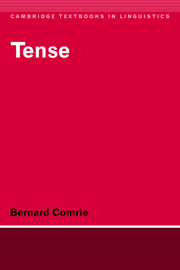3 - Relative tense
Published online by Cambridge University Press: 05 June 2012
Summary
Pure relative tense
In chapter 2 we illustrated absolute tense, whereby the reference point for the location of a situation in time is the present moment. We now turn to relative tense, where the reference point for location of a situation is some point in time given by the context, not necessarily the present moment. The phenomenon of relative tense will first be illustrated by examples from English: although English finite verb forms have absolute time reference in nearly all instances (for exceptions, see chapter 6), English non-finite verb forms characteristically have relative time reference. Subsequently, examples will be cited from other languages, in particular languages where relative time reference plays a more substantial role in the grammar overall, whether in non-finite constructions (e.g. Latin) or in finite constructions as well (e.g. Classical Arabic).
But before looking at relative tenses, in particular in contrast with absolute tenses, it will be useful to look at the conceptually identical distinction with time adverbials, since here it is somewhat easier to see precisely the factors involved. Some time adverbials serve specifically to locate a situation relative to the present moment, e.g. today (the day including the present moment), yesterday (the day preceding the day including the present moment), tomorrow (the day following the day including the present moment); in our terminology, these are all instances of absolute time reference.
- Type
- Chapter
- Information
- Tense , pp. 56 - 82Publisher: Cambridge University PressPrint publication year: 1985



